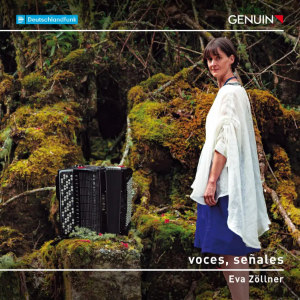
voces, señales
Eva Zöllner (piano accordion)
rec. 2020/22, Deutschlandfunk Kammermusiksaal, Cologne, Germany
Genuin GEN23838 [63]
There was a time when the piano accordion was not taken all that seriously. People associated it, I suppose, with French café music. But for many years now that has changed, perhaps at first due to Astor Piazzolla. The instrument even found its way into the Trinity College examination syllabus.
Eva Zöllner prefaces the musical descriptions in the booklet with this comment: ‘When I travelled to Columbia for the first time in 2015 to work with local composers and perform their music, I was fascinated by this country.’ Here are six works by Columbian composers of her own generation, with the accordion at the centre, in three of the works as part of an electro-acoustic ensemble.
Anna Maria Romano G, a sound artist, composed posdomingo 02.10.2016. She writes that she is interested in ‘the political dimensions of art’, however risky the mixing of music and politics might be. The piece was motivated by the breakdown of a peace agreement with an indigenous guerrilla movement. Angry at this abject failure, the composer responded with a work which mixes ‘people, spaces, stories, and places’ into a dialogue. Sometimes, the accordion blends sometimes imperceptibly into the ensemble, sometimes it is exposed. The work is dramatic and sometimes alarming.
Carlos Andrés Rico’s Nacido en el Valle, el Río y la Montaña is written for accordion and fixed media electronics. It is an attempt to bring Vallenato music associated with festivals in rural Columbia ‘into a contemporary context’. The electronics appear to create a space and atmosphere around which the more tonal festive music hovers. While it is a witty and original idea, it does not come off for me.
Jorge Gregorio García Moncada’s Un amor, puro e incondicional, also for accordion and fixed media electronics, is another work inspired by a political event. The assassination of the presidential candidate Jorge Eliécer Gaitán in April 1948 plunged Colombia into prolonged violence. The composer’s mother, who remembers the event, is heard speaking about it over the work’s almost fourteen minutes (as does the male voice in Steve Reich’s Different Trains). The composer speaks of ‘remembrance culture’: the accordion acts as a link to his childhood experiences, when his mother played for him waltzes on the instrument. To me, the accordion’s musical material seems rather banal, and the work does not capture the mood it is supposed to represent.
It seems that accordion has a great power to evoke memory. It does it again in Carolina Noguera Palau’s Canto del ave negra. She writes that she is ‘recollecting fragments of her childhood’ with material from traditional and popular music. She also says that ’the accordion is a tremendously powerful machine’; that becomes clear when one hears this work. Once more, there is presumably a direct association with Vallenato music but I could not detect anything in that line – probably my fault.
The accordion is allowed to speak alone in Natalie Valencia Zuluaga’s evocative Brother. It consists, she says, of ‘small gestures’ which move slowly and often delicately as if through a landscape. She was inspired in part by Toni Morrison’sBeloved, in which an important tree is named Brother. The piece starts slow but at halfway the tempo quickens and the music becomes agitated. This is a series of sounds and atmospheric effects, but it communicates directly.
David Leguizamón’s segno a cambio is also for accordion solo. He writes: ‘my pieces are as windows that can be filled with all kinds of worlds by those who accept the invitation’. The work is inspired by two Columbian artists, a painter and a lyricist, who he feels resonate with his own artistic concepts. He extricates from the accordion a series of slow-moving growls and snarls, which seem to have little connection with that inspiration. They are, I think, quite contrary to Manuel Hernández’s paintings, quite colourful and energetic.
To sum up: the recording is close and captivating, and there are helpful booklet notes by the composers and by the incredible Eva Zöllner. But the music will take a great deal of getting used to.
Gary Higginson
Help us financially by purchasing from



Contents
Ana Maria Romano G (b. 1971)
Posdomingo 02.10.2016 (2016)
Carolina Naguera Palau (b. 1978)
Canto del ave negra (2018)
Carlos Andrés Rico (b. 1986)
Nacido en el Valle, el Río y la Montaña (2015)
Daniel Leguizamón (b. 1979)
signo a cambio (2022)
Natalia Valencia Zuluaga (b. 1976)
Brother (2022)
Jorge Gregorio García Moncada (b. 1975)
Un amor, puro e incondicional (2016)

















